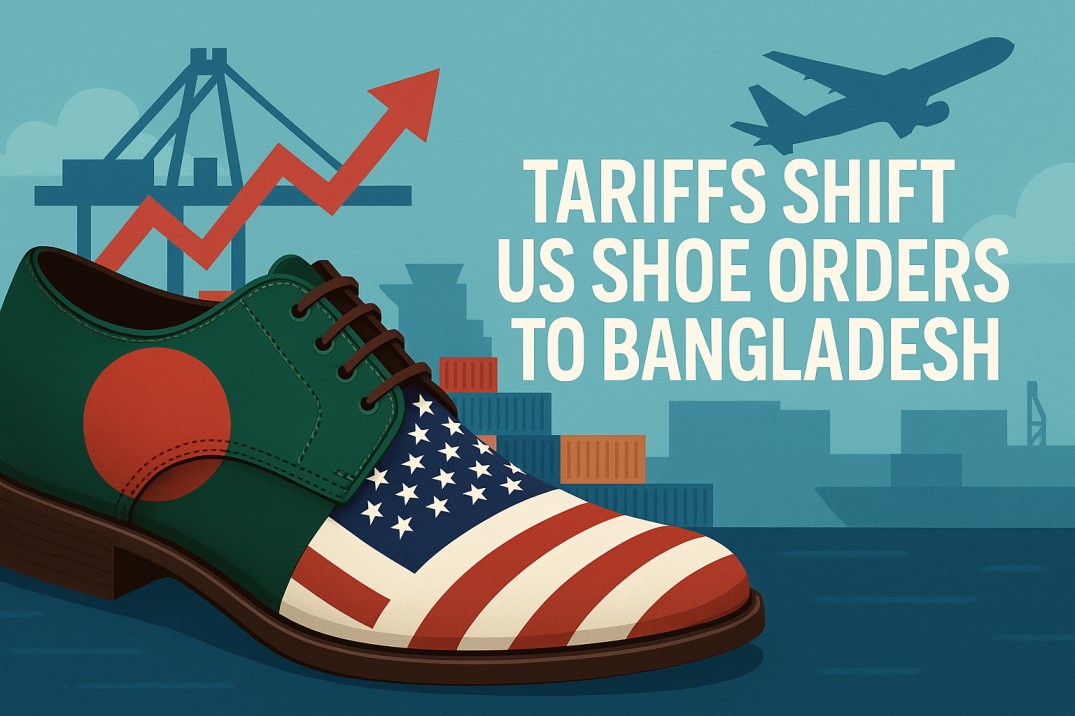After the United States imposed higher tariffs on Chinese footwear, global brands have started looking for alternative sourcing hubs. Bangladesh, with its growing non-leather and synthetic footwear industry, is emerging as a major beneficiary of this shift.
What’s Fueling the Shift?
Tariff Advantage:
- Bangladesh successfully negotiated a 20% U.S. import tariff on its leather and footwear products—significantly lower than China’s (~30%) and India’s (~50%) tariffs.
- This competitive edge is translating into growing U.S. orders and renewed interest from American buyers.
Export Surge in Numbers
- Leather and footwear exports from Bangladesh reached $1.7 billion in FY 2024-25, marking a 14.45% increase year-over-year
- U.S.-bound shipments accounted for $397.5 million, representing about 20–25% of the total—up 42% compared to the previous year
.
Mixed Fortunes for Synthetic Footwear
- Synthetic (non-leather) footwear exports nearly doubled—from $244 million to $523 million between FY 2017-18 and FY 2024-25.
- However, as of August 1, 2025, the U.S. imposed a 50% tariff on these products—combining an existing 15% duty with an additional 35%—raising concerns about Bangladesh’s ability to compete, particularly against Vietnam, which faces only a 20% tariff.
- As a result, some factories report that 95% of U.S. orders are temporarily halted, raising alarm over cash flow and job security..
Voices from the Industry
- Mohammed Nazmul Hassan (Leatherex Footwear & LFMEAB): The U.S. tariff advantage has opened a “window of opportunity,” but long-term gains hinge on government support—especially in improving infrastructure and utilities
- Hasanuzzaman (Bling Leather Products Limited): Lower tariffs have already led to U.S. order diversions from competitors like China—but timely delivery and effective customs services are critical to retaining buyer confidence
- Other companies, including Akij Footwear, have similarly reported rising U.S. demand. For Akij, the U.S. accounted for roughly 60% of its last-year turnover
The Business Standard
.
Opportunities vs. Challenges
Strengths:
- Strong tariff advantage makes Bangladesh highly competitive.
- Growing demand across multiple product segments—leather, synthetic, and non-leather.
Headwinds:
- New tariffs on synthetic shoes threaten recent export gains.
- Infrastructure concerns: frequent power/gas outages and inefficient logistics deter investment
- Regulatory bottlenecks: Customs delays and unclear trade policies hamper responsiveness
Outlook & Strategic Imperatives
| Sector | Trend | Call to Action |
|---|---|---|
| Leather Footwear | Gaining U.S. share due to 20% tariff advantage | Improve infrastructure and logistics to sustain growth |
| Synthetic Footwear | Growth slowed by new U.S. tariff hike | Engage in tariff negotiations or explore alternative markets |
| Non-Leather Segment | Strong export trajectory amid regulatory ease | Leverage production agility and scale up capabilities |
To secure long-term gains, stakeholders must prioritize upgrading infrastructure, easing regulatory processes, and investing in resilient supply chains. This will help Bangladesh convert its current export momentum into lasting global competitiveness.
Bangladesh stands at a critical juncture—its leather and footwear sectors enjoy tariff-based export advantages, while non-leather and synthetic segments face significant headwinds. With strategic investment and policy support, however, the country can transform this moment into a durable pathway for export leadership.
